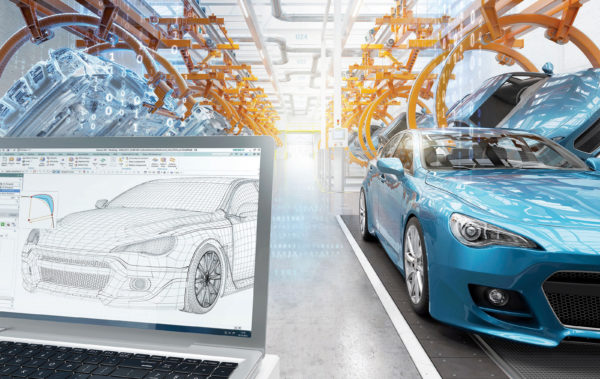Automotive Verification – speed bumps for an industry on the move (pt. 2)

The automotive industry is evolving dramatically. As discussed in a prior blog, cars are becoming far more complex in an effort to attract prospective customers by enhancing the driving experience with software integration and increased electronic capabilities. Vehicles are also transitioning from internal combustion engines (ICEs) toward all-electric or hybrid-electric powertrains due to increasing environmental regulation.
At the same time, there is growing governmental regulation, escalating recalls and warranty issues and staggering penalties for environmental infractions. The established method of developing new vehicles is far too slow, inaccurate and costly endeavor that fails to address the new world of vehicle compliance and verification.

Growing regulation
Environmental regulations and legislation surrounding climate change are changing many industries, but have a profound impact on the automotive and transportation sector. Globally, governments are introducing an increasing number of strict regulations, emissions targets and technologies to address the threat of climate change. Some cities and even entire countries are restricting internal combustion engine (ICE) vehicle operation, through fees to access metropolitan centers like London in an ICE vehicle or by completely banning their sale as Norway has proposed for 2025. In response, many automotive companies are proactively changing their business models by phasing out ICEs in favor of EVs.
Adherence to these new regulations is very important to the continued success of an automotive manufacturer because, at a minimum, a lack of compliance will result in penalties and fines from the relevant governing organization. Gross negligence or disregard for the regulation have much greater implications. Consequences can include criminal prosecution and even imprisonment. This is motivating the industry to demonstrate compliance to the relevant regulators. Traditional methods are not enough to fully verify the performance and safety of the highly integrated mechatronic systems that make up today’s vehicles rolling off the production lines.
Expensive consequences
As mentioned in the previous blog post, the market place can be the most unrelenting of regulatory agencies. The new, complex vehicle designs are also changing the landscape for customers and their perception of the manufacturers. Warranty repairs and recalls are trending upward across the entire industry due to the increase in software content and complexity. This can have a highly detrimental effect on the manufacturers from a branding perspective as well as a monetary one, especially for new technologies like autonomous driving or innovative battery technology.
Recalls are increasingly initiated by the manufacturers, rather than at the direction of government or regulatory agencies, because of unforeseen flaws in vehicle designs. These mechatronic systems are very difficult to verify because software is so easy to change. It is difficult to know how a change in a line of code will propagate through the system and impact other critical components. Not all of these changes will result in a loss of safety, some tweaks may simply create a nuisance for the driver, but it is important that the manufacturer understands how each change impacts the whole system.
For example, in one hydraulic system, a small change in the way a solenoid valve was activated to overcome internal inertia and resistance resulted in a major noise and durability problem. Yes, the software fixed the initial problem, but other performance attributes were degraded to the point the valve basically destroyed itself.

Producing a profitable vehicle at the end of development requires a new method to understand the implications of small changes to the quality and safety of a multi-ton machine that will eventually be driven at high speed. After lawsuits, redesigns, remanufacturing and government fines, the total cost of a recall can reach billions of dollars, without considering the loss of customer trust to the brand.
While the pressures of the market on the automotive and transportation industry provide a strong motivation for compliance, the traditional regulatory compliance mechanisms are also growing in severity. Failing to achieve the Corporate Average Fuel Economy (CAFÉ) targets set by the United States Environmental Protection Agency (EPA) can result in millions of dollars in fines and penalties for automotive manufacturers. Dealing with such fines is a detriment to stock owners and boards, creating yet another internal demand for a change of process.
In recent cases of companies caught lying or cheating the regulations, not only have the companies been dealt hefty financial penalties, but criminal suits have also been brought against involved parties. It is no longer an option to make a mistake, whether on purpose or accidently.
The next generation of verification and validation
A modern verification management process is required to enable the rigor and transparency needed for this stricter set of regulations. A digital thread can help with compliance and meeting growing regulation. Such an approach should provide a single source of truth—from requirements through to planning, CAD design, EBOM (Engineering Bill of Materials), simulation requests and test requests. Ideally, it should be automated not requiring manual interaction. Such a configuration also provides a single source of truth for the whole process eliminating rogue data that could corrupt the integrity of the process. Then, it needs to provide status updates on all activities and whether specific requirements, targets, deliverables have been achieved (pass/fail) and provide the necessary links to the raw data for review and confirmation.
Finally, the process workflows should be fully automated, ensuring tasks are delivered to the correct activities, monitor completion status and provide the necessary data objects (requirements, CAD, procedures, etc.) for the tasks to be completed – eliminating the need for the end user from hunting or searching for information. The future of verification management exists. For an in-depth look at how it can help to organize the complex world of automotive design today, watch for the rest of the posts in this story. Siemens is here to help your business on its digital transformation journey.
To continue reading about next generation verification management solutions, check out parts three and four. Or, if you missed it, part one is available here.



Comments